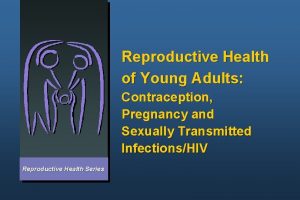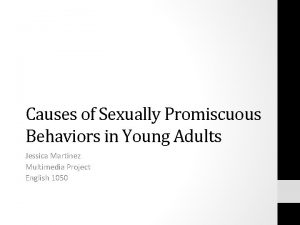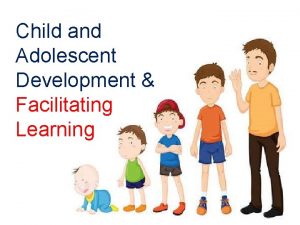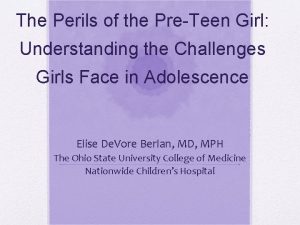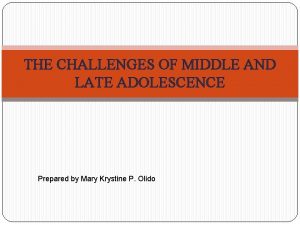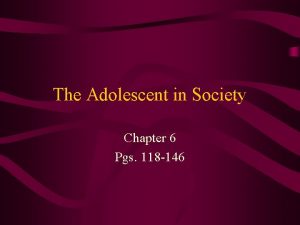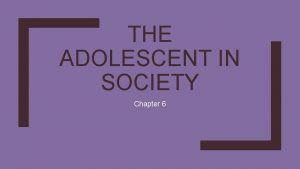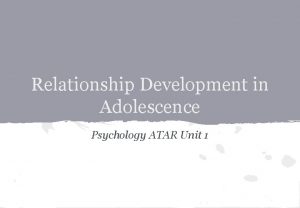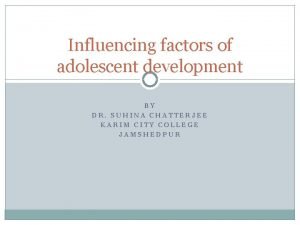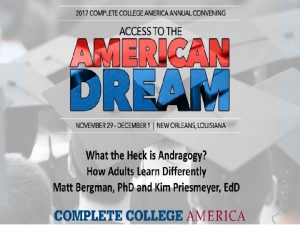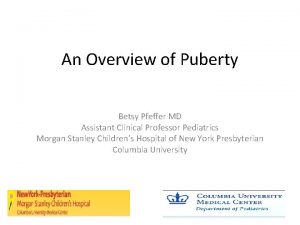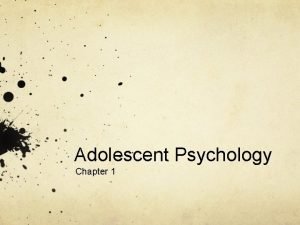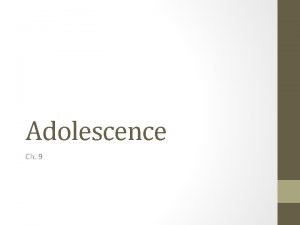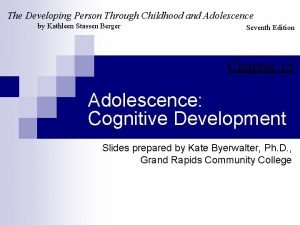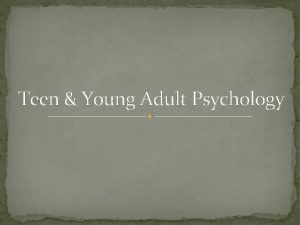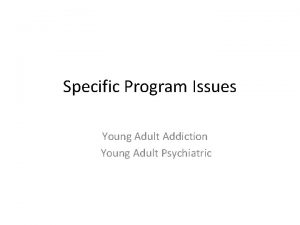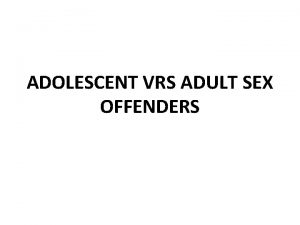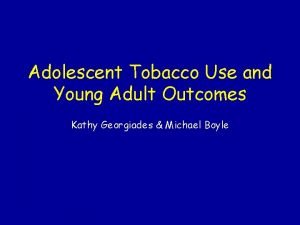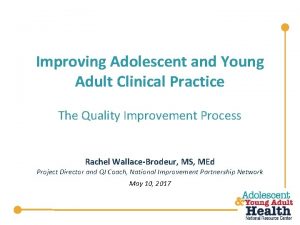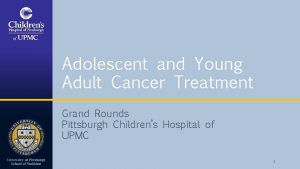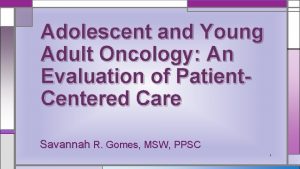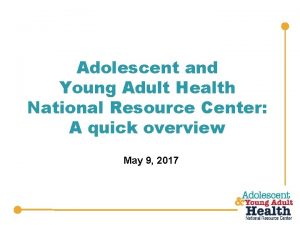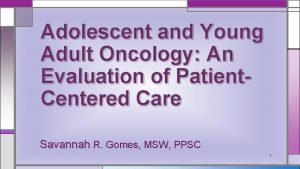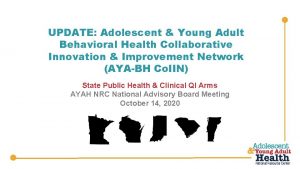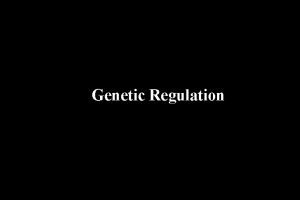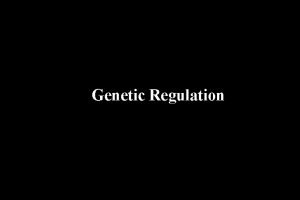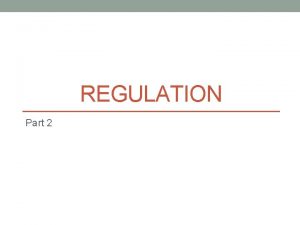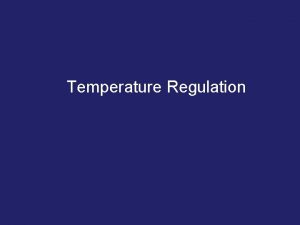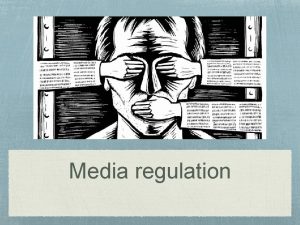Adolescent Young Adult ECigarette Regulation Law Policy and




























- Slides: 28

Adolescent & Young Adult E-Cigarette Regulation: Law, Policy and Advocacy Prof. Molly Mc. Nulty, JD, Assistant Professor of Public Health Law Contributions by Prof. Scott Mc. Intosh Ph. D, Associate Professor of Public Health Sciences; Research Director, Social & Behavioral Sciences; Matthew Quick, B. A. Candidate 2021 Political Science; Krystalyn Bates, D. O. , Preventive Medicine Resident, University of Rochester Medical Center. Thanks to the Association of Teachers of Maternal & Child Health, whose Innovative Teaching Award underwrote the development of this curriculum.

Learning objectives 1. Define the problem of adolescent nicotine addiction and the public health ramifications 2. Summarize the history of tobacco regulation 3. Describe policy options for regulating nicotine consumption by adolescents and young adults 4. Explain how the legal doctrine of “preemption” affects regulation of nicotine consumption by adolescents and young adults

Adolescent & Young Adult Nicotine Addiction and the Public Health Ramifications

Electronic Cigarettes § Also known as, “E-Cigs”, “Electronic Nicotine Delivery Systems” (ENDS), vaping, etc. § Nicotine, additives, and flavorings are heated and inhaled as vapor § All major cigarette companies produce ECigs. § Targeting includes adolescents and young adults (candy, fruit flavors) § New Regulations are still emerging at State and Federal Levels

It is Not Just Water Vapor § E-cigs contain toxicants including nicotine, volatile organic compounds (e. g. , formaldehyde), tobacco specific nitrosamines (e. g. , NNK), heavy metals (e. g. , cadmium, lead, copper), propylene glycol, ultrafine particles § Flavorings of vaping products are designed with taste in mind. Research is revealing that these chemicals designed for taste cause both immediate and long-term damage to the lungs § E-cigs generate secondhand vapor (exhaled by user) and thirdhand vapor (lingering particulate matter in the air) • • Studies from the University of Rochester; Irfan Rahman Laboratory and the Tobacco Cessation ad Prevention Research Program

Inhaled Nicotine and COVID-19 § Toxicants (such as those found in vaped or smoked tobacco products) change the cells of the lungs, doubling the impact of COVID 19 on the body § Vaping is associated with a 5 -7 times risk of developing COVID 19 in 13 -24 years olds § In other words, people who vape or smoke are twice as likely to feel sick, twice as likely to have a severe illness and twice as likely to die from a COVID-19 infection

The Public Health Problem § Addiction to nicotine, not tobacco § Adolescent smoking § Adolescent vaping § Over 33% of middle and high schoolers § Adolescent purchase of e-cigarettes provided by older teens age 18 -21 § Age of initiation at about age 14 § Addicted at about age 17

Health Outcomes § EVALI (E-cigarette or Vaping Product Use-Associated Lung Injury) - Lung failure due to large-scale swelling likely cause by fat soluble chemicals found in some vaping products § In animal models, vaping has been shown to cause inflammation patterns similar to those of smoked tobacco use § Definitive long-term effects can only be hypothesized due to the novelty of vaping development; however, the carcinogens and toxicants identified to date have been studied for decades, and have demonstrated long-term morbidity and mortality.

Health Misinformation: Myths vs. Reality There is widespread and highly-viewed pro-vaping content on many social media platforms. Common myths include: § Nonaddictive: the ingredient nicotine is addictive; current neurophysiological research is showing evidence that nicotine directly dysregulates the brain’s limbic system; causing increased irritability, anxiety, and impulsivity § Helps quit smoking: only 6% (compared to standard 30%) of people who used vaping products were able to successfully discontinue tobacco product use; and some studies mischaracterize “switching to vaping” as equivalent to “tobacco cessation” despite continued tobacco product use and addiction § Harmless: Teenagers and young adults who vape are five times more likely to catch and become seriously ill with COVID-19

History of Tobacco Regulation

Before Regulations § Large advertising campaigns put smoking at the forefront of cultural norms and people’s minds § Misinformation combined with suppression of research obfuscated the problems § Early opposition by temperance advocates

The Industry Fights Back § Industry contributed to public disbelief § § Denying harms Discrediting scientific evidence Distracting from interventions Marketing products advertised as ‘risk reduction’ § Ads with slick words § “smooth, ” “satisfying, ” “toasted” § Utilized passive advertisements in films § Media depended on this advertisement revenue § Targeted Youths to encourage early addiction and brand loyalty

Evolution of Policy: Passive Smoking § 1970 s re-framed problem as non-smokers have a right to clean air; smokers do not have right to pollute § 1972 Report on passive smoke dangers § 1986 – Surgeon General Koop report – “[t]he right of smokers to smoke ends where their behavior affects the health and well-being of others”

Evolution of Policy: Transition of “Problem Framing” from Individual to Public § 1979 Surgeon General – smoking is a public problem because § #1 health care costs spiraling upward § #2 health care system overemphasizes medical technology and disregards prevention

Evolution of Policy: Addressing Nicotine Addiction § 1960 s Initial resistance to “addict” label § 1988 “Nicotine is the drug in tobacco that causes addiction” § 1994 Addiction initiated before age 18 § Most teen smokers faced the same quitting challenges as adults § Most adult smokers report their addiction began in their teens

Adult per capita cigarette consumption and major smoking and health events, United States, 1900– 2012 Data update: in 2016, the adult per capita consumption declined to 14 cigarettes.

Industry Wrongdoing Revealed and Combatted § Master Settlement of state lawsuits § Congressional hearings § Federal Dep’t of Justice lawsuit § United States v. Philip Morris, under the Racketeer Influenced and Corrupt Organizations Act (RICO 1970). § Targeting of minors revealed § FDA gained jurisdiction to regulate Tobacco Products - 2009

Are e-Cigarettes “Tobacco Products? ” § The answer is… a complicated, but technical, Yes § The U. S. legally defines cigarettes, cigars, smokeless tobacco, shisha, e-cigarettes, vaping devices, liquid nicotine, and smoking paraphernalia as “tobacco products” § Despite a clear and specific notation in the law that specifically states that FDA-approved cessation therapies are not tobacco products § Implementation Monitoring: ** Misinterpretation by some local pharmacies lead these businesses to wrongly include Over-the-Counter Nicotine Replacement Therapy in the “tobacco products” ban, so people looking to stop vaping and/or smoking who ages 1821 sometimes cannot access recommended pharmaceutical cessation assistance without a prescription

§ Changes effective May 18 th , 2020 vaping regulations in NYS § State-registered pharmacies can no longer sell tobacco products May 18 § Prohibits the sale of flavored vapor products, which are reasonably expected to be used with nicotine. May 18 § Registration and ingredient disclosure rules for vapor product distributors both May 18 § Changes effective July 1 st , 2020 § Restrictions on tobacco products discounts (July 1) § E-cigarettes and vapor products can no longer be shipped to residential addresses July 1 § Prohibition on the display of tobacco, vapor products, and advertisements in exterior windows or storefronts within 1500 ft of schools July 1 § Increased penalties for illegally selling tobacco products to underage persons, 1 st violation $1, 500, 2 nd no more than $2, 500, 3 rd one-year registration suspension.

Policy Options for Regulation of Tobacco Products in Adolescents and Young Adults

Policy Options that have shown to be effective in smoking regulation § Smoking bans § Both protected nonsmokers and encouraged cessation § Enforced age limit laws § Limiting youth access to tobacco products § Raising taxes § forces the prices upward, reducing habitual use, preventing the development of long-term addiction § Using the media to counter the marketing of the tobacco industry § Encouraging smoking cessation and using treatments that are proven to be effective

Effects of Laws on Initiation Rates Institute of Medicine 2015. Public Health Implications of Raising the Minimum Age of Legal Access to Tobacco Products. Washington, DC: The National Academies Press. https: //doi. org/10. 17226/18997 • Raising the minimum age of legal access to tobacco products, particularly to ages 21 and 25, will lead to substantial reductions in tobacco use, improve the health of Americans across the lifespan, and save lives


Preemption

Preemption § Power of higher levels of government to limit or eliminate the power of lower levels to regulate public health § Example: § Georgia governor forbidding the Atlanta mayor from requiring face masks (Kemp v Bottoms) § Why Gov. Kemp Dropped His Mask Lawsuit

Impact of Federalism and Separation of Powers 9 separate governments regulate tobacco: Makes legal surveillance & advocacy very complicated. § Branches of government § Levels of government § 3 branches of government § Congress (FDA 2009) § Executive agency FDA (2019) § Courts (Master Settlement 1998) § 3 levels of government § Federal § State NYS “T 21” law 2019 § Local (cities and counties) 3 BRANCHES OF GOVERNMENT LEVELS Legislative Executive Judicial Federal Laws Regulations Opinions State Laws Regulations Opinions Local Laws Regulations Opinions

So What? Federalism impact: § Inter-branch squabbling § Inconsistent & Ever. Changing Policies Preemption Impact: § Invalidation of public health laws by higher levels § Cities and county ordinances overturned

Conclusions § Vaping has a significant impact on health and public health § Adolescent vaping is a serious and growing problem § The development of smoking regulations can provide a road map for creating effective vaping regulations § Policy solutions = Age limits, Vaping Bans, Taxes, Advertisement Regulation, and Educational Interventions § Implementation monitoring = are T 21 laws being correctly implemented by local retailers? § Preemption can be either beneficial or detrimental depending on its implementation
 Young adult age range
Young adult age range Promiscuous behavior
Promiscuous behavior Characteristics of young adult literature
Characteristics of young adult literature Newton's first law and second law and third law
Newton's first law and second law and third law Si unit of newton's first law
Si unit of newton's first law Scaffold and fade-away technique
Scaffold and fade-away technique Boyles law
Boyles law Constant of avogadro's law
Constant of avogadro's law Infant child and adolescent berk 8th edition chapter 1
Infant child and adolescent berk 8th edition chapter 1 Pre adolescent girl
Pre adolescent girl Challenge of middle and late adolescence
Challenge of middle and late adolescence Undefined status adolescence
Undefined status adolescence Developmental tasks for adolescent
Developmental tasks for adolescent Adolescents defenition
Adolescents defenition Dexter dunphy 5 stages
Dexter dunphy 5 stages Adolescent age range psychology
Adolescent age range psychology What factors influence adolescent development
What factors influence adolescent development Sigmund freud and erik erikson
Sigmund freud and erik erikson Industry vs inferiority erikson
Industry vs inferiority erikson Elkind's theory of adolescent egocentrism
Elkind's theory of adolescent egocentrism Adolesence period
Adolesence period Adolescent turmoil definition
Adolescent turmoil definition It is the art & science of helping adolescent learn
It is the art & science of helping adolescent learn Early adolescent age
Early adolescent age Adolescent generalization gap
Adolescent generalization gap Erikson's stage of adolescence
Erikson's stage of adolescence Adolescent generalization gap
Adolescent generalization gap Adolescent egocentrism
Adolescent egocentrism The developing person through childhood and adolescence
The developing person through childhood and adolescence
